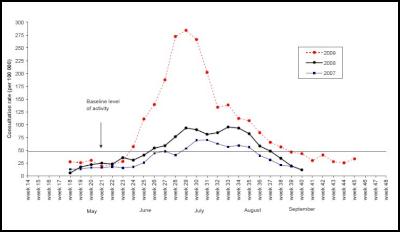Swine Flu - Update 161
18 November 2009
Media Release
Pandemic Influenza (H1N1) 09 Swine Flu - Update 161
Influenza activity in New Zealand continues to to be low, with visits to doctors for influenza-like illness (ILI) being below the "baseline" level. Deaths attributed to pandemic influenza remain at 20.
Graph of weekly consultation rates for influenza-like illness in New Zealand, 2007-2009

Click for big version
Source: Institute of Environmental Science and Research, Influenza Weekly Update
Based on our experience and those of other countries, only a small minority of patients develop severe illness. However, the risk factors for severe disease are similar to those identified for complications from seasonal flu. Persons at increased risk of more complicated or severe illness associated with infection by the pandemic influenza virus include children under five years, pregnant women, patients who are severely obese or with chronic pulmonary, cardiac, renal and/or liver disease, and patients with immunosuppression related to treatment for cancer or due to other diseases.
People who are ill and their caregivers should be aware of the warning signs for severe influenza, and when to seek medical care. Information on the signs and symptoms of influenza, and tips in caring for yourself and others are available on the Ministry of Health website (http://www.moh.govtnz/influenza-a-h1n1 ). Free medical advice is available on Healthline (0800 611 116).
International situation
The World Health Organization’s latest update on 13 November 2009 cited over half a million laboratory-confirmed cases and at least 6200 deaths. Cases have been reported from nearly all countries and territories.
Rates of ILI show early signs of peaking in parts of North America and are intensifying across much of Europe and Central and Eastern Asia. Further information on the progress of the pandemic is available on the WHO website: http://www.who.int/csr/don/2009_11_13/en/index.html
With the infection now being widespread overseas, particularly in the northern hemisphere, it would be wise for New Zealanders planning overseas travel to be aware of the situation and to take appropriate precautions when away. In particular, they should follow the same basic precautions that stood us in good stead during our earlier wave here - regularly washing and drying hands, staying away from people who are unwell, covering coughs and sneezes, and staying away from others if they themselves become sick.
WHO has just released a document outlining key planning considerations for organisers of mass gatherings in light of the pandemic. The document is a useful resource for event planners given the continuing spread of the pandemic influenza virus worldwide. http://www.who.int/csr/resources/publications/swineflu/h1n1_mass_gatherings/en/index.html
ENDS


 NZ Symphony Orchestra: NZSO To Tour Masterworks By Mozart, Beethoven, Haydn And More
NZ Symphony Orchestra: NZSO To Tour Masterworks By Mozart, Beethoven, Haydn And More Journal Of Public Health: Vape Shops Cluster Around Schools
Journal Of Public Health: Vape Shops Cluster Around Schools Timaru District Council: Aigantighe Art Gallery Hosts An Iconic Robin White Touring Exhibition
Timaru District Council: Aigantighe Art Gallery Hosts An Iconic Robin White Touring Exhibition Victoria University of Wellington: Dame Winnie Laban Awarded Honorary Doctorate Recognising Achievements For Pasifika
Victoria University of Wellington: Dame Winnie Laban Awarded Honorary Doctorate Recognising Achievements For Pasifika  HESSA: This Isn’t Fair—And It’s Time To Fix It - HESSA Petition Calls For Inclusive Student Sports
HESSA: This Isn’t Fair—And It’s Time To Fix It - HESSA Petition Calls For Inclusive Student Sports Post Primary Teachers' Association: PPTA Calls On Minister Stanford To Come Clean On Kāhui Ako
Post Primary Teachers' Association: PPTA Calls On Minister Stanford To Come Clean On Kāhui Ako 